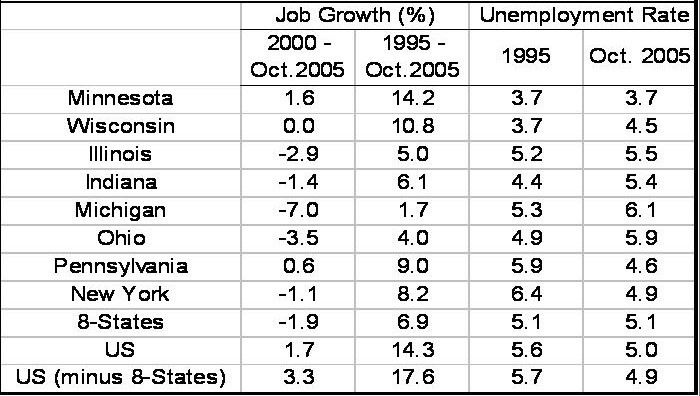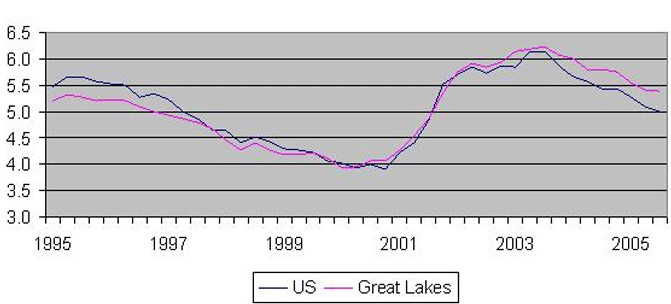Great Lakes: Economy and water
The Council of Great Lakes Governors convenes December 13, 2005, in Milwaukee. At that time, the governors will discuss progress on region-wide procedures to regulate, protect, and control diversions of the waters of the Great Lakes basin, the largest single body of surface water in the world. Such actions are laudable for their foresight in sustaining the health of the Lakes ecosystem. Interstate cooperation in fashioning public policy is difficult and rare. Inspired by such achievements in the environmental arena, should the region’s leaders aspire to broader cooperation to spur economic growth and development?
The Council of Great Lakes Governors, formed in 1983, is a non-partisan partnership of the eight states that border the Lakes—Illinois, Indiana, Michigan, Minnesota, New York, Ohio, Pennsylvania, and Wisconsin—along with the Premiers of Ontario and Quebec. The council’s goals are both environmental and economic.
Next week’s agreements to address water diversions are but one of several initiatives that the governors are engaged in to improve the health of the Great Lakes ecosystem. Through the Great Lakes Governors’ Priorities Initiative, the council has established a list of nine priorities to guide the restoration and protection of the largest single source of freshwater in the world, the Great Lakes. Most of these priorities are being addressed more broadly in the U.S. by the Great Lakes Regional Collaboration, which was created by executive order in 2004. The collaboration includes the EPA-led federal agency task force, the Great Lakes states, local communities, Native American tribes, non-governmental organizations and other interests in the Great Lakes region. The first goal of the Collaboration is to create a workable strategy to restore and protect the Great Lakes ecosystem. Past abuses of the Lakes include the introduction of invasive species, destruction of sensitive shoreline habitat, and the introduction of persistent toxins and pollutants. Today’s threats include increased demands for consumptive uses of Great Lakes water; pollutants from land, sea, and air; erosion of coastal habitat through onshore development; and imminent introduction of invasive species such as the Asian carp.
Should similar interstate cooperative efforts be marshalled for economic growth and development? Some limited efforts are being taken already. Through the Council of Great Lakes Governors, a group of five of the Great Lakes states maintain a non-competitive partnership in international trade initiatives. Five states share overseas trade offices that offer responsive and comprehensive services to small and medium sized companies seeking to expand product and service sales.
In addition, one might argue that proper stewardship of the watershed itself is highly important to the economy. Regionwide organizations such as the Great Lakes Commission address the use of the waters for maritime transportation and tourism-related activities. A Council of Great Lakes Industries tries to preserve the region’s industrial activity and balance the needs of industry with those of the environment.
The Lakes ecosystem is also important to what the region’s economy is becoming. Quality of life, especially human health and outdoor recreational amenities, are increasingly important in attracting the highly skilled and highly mobile knowledge workers of “the information economy.” As family income and educational attainment grow in the U.S., demands for environmental quality grow more than proportionately. Primary residences adjacent to scenery and open waters are in ever greater demand. More people are buying second and even third homes for vacation and retirement. A small but growing subset of households follows the seasons residence by residence suggesting that, over time, the Great Lakes attractiveness as a site of seasonal homes is likely to expand.
Still, as we stand at mid-decade, the Great Lakes economy appears to have lost some steam from ten years ago (chart and table below). At that time, the region was celebrating a return to prosperity from the tougher times of the 1980s (see Assessing the Midwest Economy project of Fed). Labor markets in the mid-1990s were tighter in the region than the nation, with concerns of work force shortages about to emerge.
Table 1. Great Lakes states

Figure 1. Unemployment rate, quarterly — 1995-2005 Q3

Since 1995, the region’s payroll employment has grown by one-half of that of the rest of the U.S., and the region’s unemployment rate is higher than the nation. Over the past five years, payroll job growth has declined.
The region may yet flex its economic muscles during this decade. But concerns are growing that the region’s economy may again be undergoing some long-term structural declines. As they meet in Milwaukee, some of the governors may rightly wonder if additional interstate efforts to boost the region’s economy might be worthwhile.
Aside from the waterways, the region’s economy is highly integrated in commerce and in shared assets, among them interstate flows of materials and intermediate parts over a common transportation network (see Hewings CFL). The region’s economy also draws from a common labor market for its work force skills. And its built assets include a university system that is arguably among the finest of any region in the world.
While it is highly important to protect our natural assets, other opportunities for the Governors may lie in developing and promoting additional assets.








